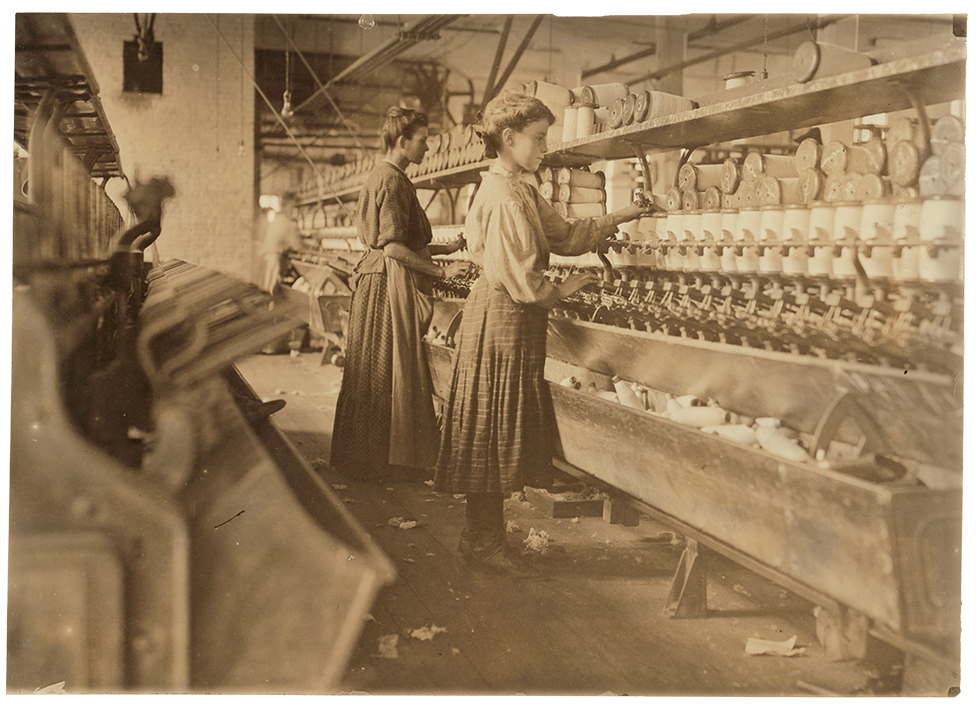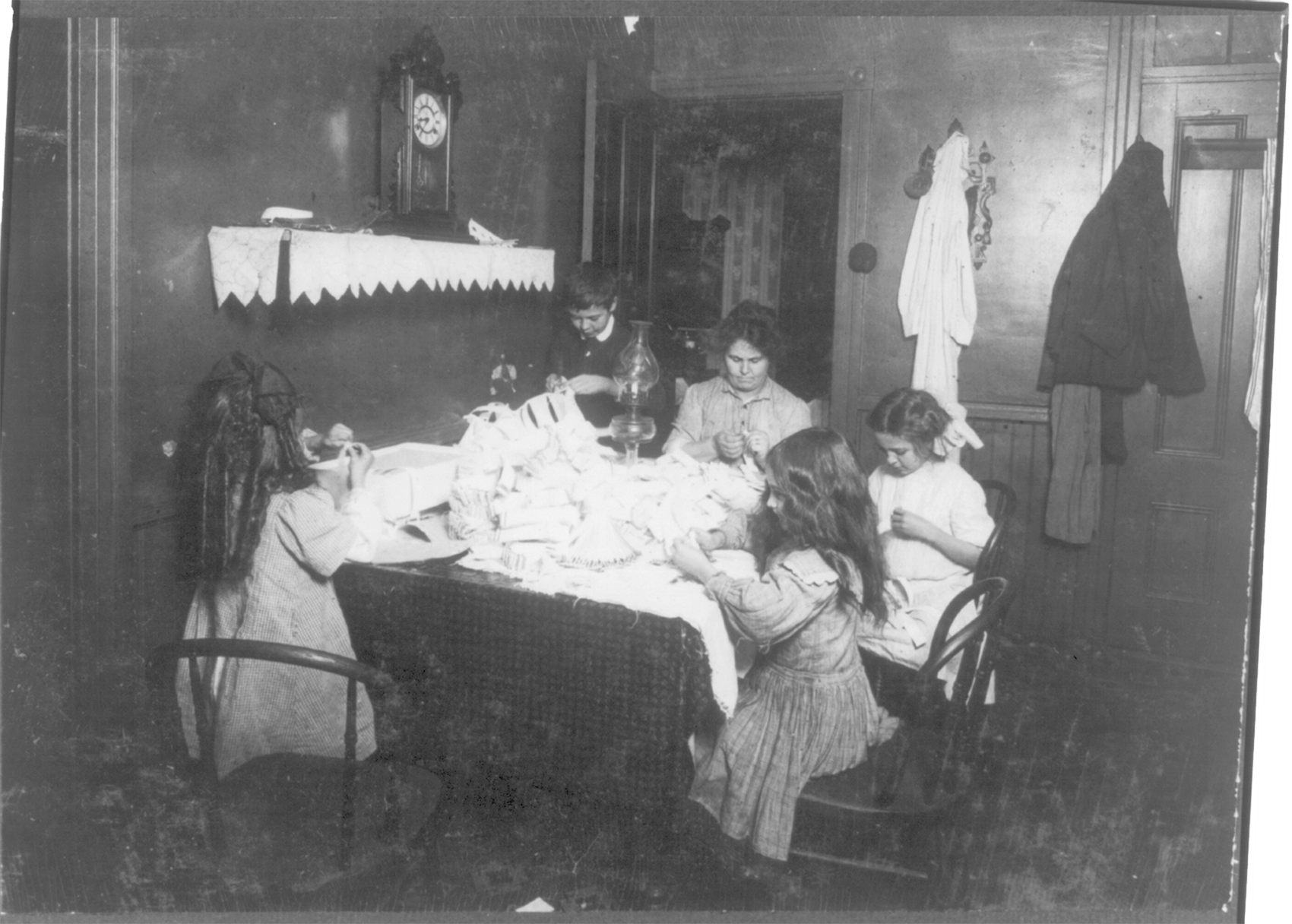Family working at home.
Photo at 9 P.M. Home of Patrick McGurl (mechanic), 136 Exchange Street, Worcester, Mass. Working on hose supporters. All work, 6-year-old, 8-year-old, 11-year-old, 12-year-old, and mother. Altogether earn about $3 a week. Work noons, after school and every night. A 9-year-old boy (not in photo) carries work back and forth. Heavy loads. Location: Worcester, Massachusetts. Lewis Hine, 1912. Library of Congress Prints & Photographs Division, Washington, D.C.
Background
The vast majority of women at this time contributed to the family economy through housework. However, the number of women working for wages was steadily increasing. By 1910, one in four women over the age of 14 was paid for her work. A single income could not support most American families. Women in low-income households had to contribute financially. Age, race, ethnicity, class, geography, economic circumstances, and family situation all had an impact on the options available. Women tended to rely on friends and family for references. Such networks were particularly important to newly arrived immigrants and migrants. While a select few might secure skilled jobs, most working women had unskilled jobs in a factory or at home.
Some women—particularly married immigrants—made money doing piece-work. Piece-work involved small, handmade work that could be done at home and dropped off at a factory. This might include sewing small garments, making paper flowers, or rolling cigars. Because a woman was paid for each completed piece, she often recruited her children to help. Women who took in piece-work were almost always still responsible for the management of the household.
Women working in factories faced long hours and dangerous working conditions. Employers required women to work quickly, often without breaks. The work was repetitive, and wages were based on the amount of work produced in a day. Each worker completed one step in the process, and men received more complex tasks. While most female factory workers were young and single, there were married and older workers. A 1911 report on the state of Southern cotton mills noted that almost 29 percent of female cotton mill workers were married. It is likely that married workers still had to manage cooking, cleaning, and children after a long day of work.
Industrial work in the home and in the factory was considered a valued position that was almost exclusively open to white and European immigrant women. Black women and non-European immigrants were excluded from most industrial work. Many of them found paid work in the domestic sector, working as maids, cooks, or laundresses.
About the Image
This pair of images presents two different forms of waged work in the early twentieth century. In the first image, a woman and young girl are at work in the Globe Cotton Mill in Augusta, Georgia. Lewis Hine, the photographer, notes that the woman is “with child,” or pregnant. In the second image, a woman is completing piecework at her home with her children. The family is making hose supporters, which were used to keep men’s socks and women’s stockings—or hose—from slipping down to the ankles.
Lewis Hine was a Wisconsin-born documentary photographer who lived in New York City and took thousands of pictures of immigrants and workers. Between 1907 and 1918, he worked for the National Child Labor Committee and traveled across the country photographing children at work. Although his primary focus was children, many of his images also captured women.
Vocabulary
- documentary photographer: A photographer who takes pictures of what he or she observes in the world.
- domestic work: Paid work done in someone’s home, including cooking, cleaning, and taking care of children.
- hose supporters: An article of clothing that kept stockings and socks from falling down before the invention of elastic.
- National Child Labor Committee: A non-profit organization founded in 1904 that promoted fair treatment of children in the work place and sought to abolish the employment of children in certain industries.
- piece-work: Small, handmade work that could be done at home and dropped off at a factory.
Discussion Questions
- What are the key differences between these two types of work environments? What are the similarities?
- Many married women took in piecework so that they could be at home and still contribute to the family’s income. What challenges might these women have faced doing their work at home instead of in a factory?
- Both images also depict children—mainly young girls—at work. What do you think this work would have been like for them?
Suggested Activities
- Lesson Plan: In this lesson designed for fourth grade, students will learn about industrialization and factory work during the early 20th century.
- Explore the competing roles of mother and wageworker by pairing these images with the Supreme Court opinion for Muller v. Oregon.
- Industrial work was almost exclusively open to white women. Black women and non-European immigrants were often forced to work in the domestic sector. Compare these images with Fanny Barrier Williams’s description of Black women in Chicago and the articles about El Paso laundry workers to explore the differences between industrial and domestic work.
- Many women fought to improve the types of working conditions depicted in these images. Read the life story of Clara Lemlich Shavelson to learn how garment workers in New York City fought for better work conditions.
- Connect Lewis Hine’s work to that of muckraker Elizabeth Cochrane (aka Nellie Bly), who used journalism to shed light on the challenges of life in modern industrial America.
- Raising a family and working for wages was a balancing act many women faced. Examine these two images and then analyze Margaret Sanger’s clinic poster, which argues in favor of women controlling reproduction.
Themes
WORK, LABOR, AND ECONOMY; DOMESTICITY AND FAMILY; ACTIVISM AND SOCIAL CHANGE








